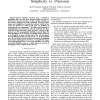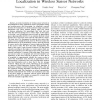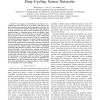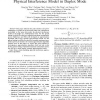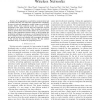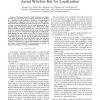INFOCOM
2012
IEEE
12 years 5 months ago
2012
IEEE
—Localization techniques that allow inferring the location of wireless devices directly from received signals have exposed mobile users to new threats. Adversaries can easily col...
INFOCOM
2012
IEEE
12 years 5 months ago
2012
IEEE
—Internet backbone operators face a trade-off in quantifying the costs that their customers inflict on their infrastructure since the precision of these methods depends on the r...
INFOCOM
2012
IEEE
12 years 5 months ago
2012
IEEE
—With the proliferation of mobile devices in both smartphone and tablet form factors, it is intuitive and natural for users to socially interact with their collaborators or compe...
INFOCOM
2012
IEEE
12 years 5 months ago
2012
IEEE
—Accurate localization in wireless sensor networks is the foundation for many applications, such as geographic routing and position-aware data processing. An important research d...
INFOCOM
2012
IEEE
12 years 5 months ago
2012
IEEE
Abstract—In this paper, we investigate the problem of controlling node sleep intervals so as to achieve the min-max energy fairness in asynchronous duty-cycling sensor networks. ...
INFOCOM
2012
IEEE
12 years 5 months ago
2012
IEEE
—This paper addresses the joint selection and power assignment of a largest set of given links which can communicate successfully at the same time under the physical interference...
INFOCOM
2012
IEEE
12 years 5 months ago
2012
IEEE
—Data aggregation, as a primitive communication task in wireless networks, can reduce the communication complexity. However, in-network aggregation usually brings an unavoidable ...
INFOCOM
2012
IEEE
12 years 5 months ago
2012
IEEE
—This paper presents a fully functional and highly portable mini Unmanned Aerial Vehicle (UAV) system, HAWK, for conducting aerial localization. HAWK is a programmable mini helic...
INFOCOM
2012
IEEE
12 years 5 months ago
2012
IEEE
—There has been a recent trend that video-on-demand (VoD) providers such as Netflix are leveraging resources from cloud services for multimedia streaming. In this paper, we cons...
INFOCOM
2012
IEEE
12 years 5 months ago
2012
IEEE
—We study the capacity and delay scaling laws for cognitive radio network (CRN) with static primary users and heterogeneous mobile secondary users coexisting in the unit planar a...

